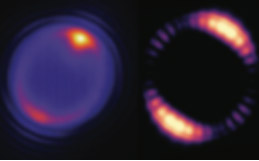
Scientific Achievement
An international team of scientists led by Foundry researchers has found a way to convert nanoparticle-coated microscopic plastic beads into lasers smaller than red blood cells.
Significance and Impact
The lasers have the lowest lasing thresholds reported for an upconverting nanoparticle laser and can operate continuously, for hours or days. This breakthrough will enable technologies that are tailored for operation in confined spaces like ultrahigh-speed microprocessors or live brain tissue.
Research Details
- The researchers incorporated 3 innovations in their design to lower the upconverting lasing threshold: polystyrene beads which are known to host ‘whispering gallery modes’; thulium-doped energy-looping nanoparticles; controlling deposition of the nanoparticles onto the bead surface.
- When excited with a specific wavelength of light (1064-nm), the nanoparticles upconvert the light in an avalanche-like energy looping mechanism where the emitted light bounces around inside the bead thousands of times, causing positive interference at certain frequencies and creating a brighter signal.
- At a certain threshold, the light can stimulate a positive feedback loop that induces stable lasing at blue and near-infrared wavelengths.
- The research team used the WANDA robotic synthesis system at the Molecular Foundry to tune nanoparticle performance.

